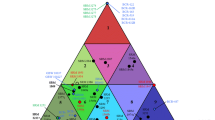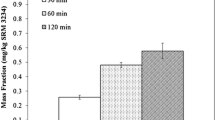Abstract
Standardized analytical methods, where each B vitamin is extracted from a given sample individually using separate procedures, typically ensure that the extraction conditions provide the maximum recovery of each vitamin. However, in the human gastrointestinal tract (GIT), the extraction conditions are the same for all vitamins. Here, we present an analytically feasible extraction protocol that simulates conditions in the GIT and provides a measure of the content of bioavailable vitamins using LC-MS stable isotope dilution assay. The results show that the activities of both human gastric and duodenal juices were insufficient to liberate absorbable vitamers (AV) from pure cofactors. The use of an intestinal brush border membrane (IBBM) fraction derived from the mucosal tissue of porcine small intestine ensured at least 70% AV recovery. The rate of AV liberation, however, was strongly dependent on the cofactor, e.g., in the case of NADH, it was magnitudes higher than in the case of thiamine diphosphate. For some vitamins in some food matrices, the use of the IBBM fraction assay resulted in lower values for the content of AV than conventional vitamin determination methods. Conventional methods likely overestimate the actual bioavailability of some vitamins in these cases.

Assessment of bioavailable B vitamin content in food
Similar content being viewed by others
References
Said HM. Intestinal absorption of water-soluble vitamins in health and disease. Biochem J. 2011;437:357–72.
Sklan D, Trostler N. Site and extent of thiamin absorption in the rat. J Nutr. 1977;107:353–6.
Middleton HM. Intestinal absorption of pyridoxal-5′ phosphate disappearance from perfused segments of rat jejunum in vivo. J Nutr. 1979;109:975–81.
Daniel H, Binninger E, Rehner G. Hydrolysis of FMN and FAD by alkaline phosphatase of the intestinal brush border membrane. Int J Vitam Nutr Res. 1983;53:109–14.
Gross CJ, Henderson LM. Digestion and absorption of NAD by the small intestine of the rat. J Nutr. 1983;113:412–20.
Shibata K, Gross CJ, Henderson LM. Hydrolysis and absorption of pantothenate and its coenzymes in the rat small intestine. J Nutr. 1983;113:2107–15.
Nabokina SM, Said HM. A high affinity and specific carrier-mediated mechanism for uptake of thiamine pyrophosphate by human colonic epithelial cells. Am J Physiol Gastrointest Liver Physiol. 2012;303:389–95.
White HB, Merril AH. Riboflavin-binding proteins. Annu Rev Nutr. 1988;8:279–99.
Combs GF Jr. The vitamins: fundamental aspects in nutrition and health. London: Academic press; 2012.
Akiyama T, Selhub J, Rosenberg IH. FMN phosphatase and FAD pyrophosphatase in rat intestinal brush borders: role in intestinal absorption of dietary riboflavin. J Nutr. 1982;112:263–8.
Ball GFM. Niacin: nicotinic acid and nicotinamide. In: Vitamins. Their role in the human body. Oxford: Blackwell Publishing; 2004. p. 301–9.
Subramanian VS, Ghosal A, Subramanya SB, Lytle C, Said HM. Differentiation-dependent regulation of intestinal vitamin B(2) uptake: studies utilizing human-derived intestinal epithelial Caco-2 cells and native rat intestine. Am J Physiol Gastrointest Liver Physiol. 2013;304:741–8.
Baum CL, Selhub J, Rosenberg IH. The hydrolysis of nicotinamide adenine dinucleotide by brush border membranes of rat intestine. Biochem J. 1982;204:203–7.
Trammell SAJ, Schmidt MS, Weidemann BJ, Redpath P, Jaksch F, Dellinger RW, et al. Nicotinamide riboside is uniquely and orally bioavailable in mice and humans. Nat Commun. 2016;7:12948.
Henderson LM, Gross CJ. Metabolism of niacin and niacinamide in perfused rat intestine. J Nutr. 1979;109:654–62.
Kumar JS, Subramanian VS, Kapadia R, Kashyap ML, Said HM. Mammalian colonocytes possess a carrier-mediated mechanism for uptake of vitamin B3 (niacin): studies utilizing human and mouse colonic preparations. Am J Physiol Gastrointest Liver Physiol. 2013;305:207–13.
Said HM. Recent advances in transport of water-soluble vitamins in organs of the digestive system: a focus on the colon and the pancreas. Am J Physiol Gastrointest Liver Physiol. 2013;305:G601–10.
Elbert J, Daniel H, Rehner G. Intestinal uptake of nicotinic acid as a function of microclimate-pH. Int J Vitam Nutr Res. 1986;56:85–93.
Nabokina SM, Kashyap ML, Said HM. Mechanism and regulation of human intestinal niacin uptake. Am J Phys Cell Phys. 2005;289:97–103.
Eto M, Nakagawa A. Identification of a growth factor in tomato juice for a newly isolated strain of Pediococcus cerevisiae. J Inst Brew. 1975;81:232–6.
Prasad PD, Wang H, Huang W, Fei YJ, Leibach FH, Devoe LD, et al. Molecular and functional characterization of the intestinal Na+-dependent multivitamin transporter. Arch Biochem Biophys. 1999;366:95–106.
Chen Y, Zhao S, Zhao Y. Efficacy and tolerability of coenzyme A vs pantethine for the treatment of patients with hyperlipidemia: a randomized, double-blind, multicenter study. J Clin Lipidol. 2015;9:692–7.
Gregory JF 3rd, Ink SL. Identification and quantification of pyridoxine-β-glucoside as a major form of vitamin B6 in plant-derived foods. J Agric Food Chem. 1987;35:76–82.
Gregory JF 3rd, Sartain DB. Improved chromatographic determination of free and glycosylated forms of vitamin B6 in foods. J Agric Food Chem. 1991;39:899–905.
Albersen M, Bosma M, Knoers NVVAM, de Ruiter BHB, Diekman EF, de Ruijter J, et al. The intestine plays a substantial role in human vitamin B6 metabolism: a Caco-2 cell model. PLoS One. 2013;8:e54113.
Gregory JF 3rd, Trumbo PR, Bailey LB, Toth JP, Baumgartner TG, Cerda JJ. Bioavailability of pyridoxine-5′-beta-D-glucoside determined in humans by stable-isotopic methods. J Nutr. 1991;121:177–86.
Tsuge H, Maeno M, Hayakawa T, Suzuki Y. Comparative study of pyridoxine- α,β-glucosides, and phosphopyridoxyl-lysine as a vitamin B6 nutrient. J Nutr Sci Vitaminol. 1996;42:377–86.
Ndaw S, Bergaentzle M, Aoude-Werner D, Hasselmann C. Extraction procedures for the liquid chromatographic determination of thiamin, riboflavin and vitamin B6 in foodstuffs. Food Chem. 2000;71:129–38.
Rychlik M. Quantification of free and bound pantothenic acid in foods and blood plasma by a stable isotope dilution assay. J Agric Food Chem. 2000;48:1175–81.
Hälvin K, Paalme T, Nisamedtinov I. Comparison of different extraction methods for simultaneous determination of B complex vitamins in nutritional yeast using LC-MS-TOF and stable isotope dilution assay. Anal Bioanal Chem. 2013;406:7355–66.
Salvati LM, McClure SC, Reddy TM, Cellar NA. Simultaneous determination of total vitamins B1, B2, B3, and B6 in infant formula and related nutritionals by enzymatic digestion and LC-MS/MS: single-laboratory validation, first action 2015.14. J AOAC Int. 2016;99:776–85.
EVS-EN 15652:2009 Foodstuffs – Determination of niacin by HPLC. Tallinn: Estonian Centre for Standardisation; 2009.
Holm H, Hanssen L, Krogdahfl A. High and low inhibitor soybean meals affect human duodenal proteinase activity differently: in vivo comparison with bovine serum albumin. J Nutr. 1988;118:515–20.
Gregory JF, Ink SL, Cerda JJ. Comparison of pteroylpolyglutamate hydrolase (folate conjugase) from porcine and human intestinal brush border membrane. Comp Biochem Physiol B. 1987;88:1135–41.
Aller K, Adamberg K, Timarova V, Seiman A, Feštšenko D, Vilu R. Nutritional requirements and media development for Lactococcus lactis IL1403. Appl Microbiol Biotechnol. 2014;98:5871–81.
Almaas H, Cases AL, Devold TG, Holm H, Langsrud T, Aabakken L, et al. In vitro digestion of bovine and caprine milk by human gastric and duodenal enzymes. Int Dairy J. 2006;16:961–8.
Sumeri I, Arike L, Adamberg K, Paalme T. Single bioreactor gastrointestinal tract simulator for study of survival of probiotic bacteria. Appl Microbiol Biotechnol. 2008;80:317–24.
EVS-EN 14122:2003 Foodstuffs – Determination of vitamin B1 (thiamin) by HPLC. Tallinn: Estonian Centre for Standardisation; 2003.
EVS-EN 14152:2003 Foodstuffs – Determination of vitamin B2 by HPLC. Tallinn: Estonian Centre for Standardisation; 2003.
EVS-EN 14663:2006 Foodstuffs – Determination of vitamin B6 (including its glycosylated forms) by HPLC. Tallinn: Estonian Centre for Standardisation; 2006.
Hälvin K, Paalme T, Vilbaste A, Nisamedtinov I. LC-MS quantification of B-group vitamins in yeast. In: Advances in Science and Industrial Production of Baker’s Yeast. Proceedings of the 27th VH Yeast Conference. 2014. p. 71–81.
Henthorn PS, Raducha M, Kadesch T, Weiss MJ, Harris H. Sequence and characterization of the human intestinal alkaline phosphatase gene. J Biol Chem. 1988;263:12011–9.
Yedlin ST, Young GP, Seetharam B, Seetharam S, Alpers DH. Characterization and comparison of soluble and membraneous forms of intestinal alkaline phosphatase from the suckling rat. J Biol Chem. 1981;256:442–52.
Sandhu M, Mahmood A. Kinetic characteristics of soluble and brush border alkaline phosphatase and sucrase activities in developing rat intestine: effect of hormones Indian. J Biochem Biophys. 1990;27:88–92.
Fan MZ, Adeola O, Asem E. Characterization of brush border membrane-bound alkaline phosphatase activity in different segments of the porcine small intestine. J Nutr Biochem. 1999;10:299–305.
Almo SC, Smith DL, Danishefsky AT, Ringe D. The structural basis for the altered substrate specificity of the R292D active site mutant of aspartate aminotransferase from E. coli. Protein Eng. 1994;7:405–12.
Miller ER, Ullrey DE. The pig as a model for human nutrition. Annu Rev Nutr. 1987;7:361–82.
Zhang Q, Widmer G, Tzipori S. A pig model of the human gastrointestinal tract. Gut Microbes. 2013;4:193–200.
Piao JH, Goding JW, Nakamura H, Sano K. Molecular cloning and chromosomal localization of PD-Ibeta (PDNP3), a new member of the human phosphodiesterase I genes. Genomics. 1997;45:412–5.
Vovk AI, Babiĭ LV, Murav'eva IV. [Relative reactivity of thiamine monophosphate and thiamine diphosphate upon interaction with alkaline phosphatase]. Ukr Biokhim Zh (1999). 2002;74:93–6. [Article in Russian]
Paalme T, Kevvai K, Vilbaste A, Hälvin K, Nisamedtinov I. Uptake and accumulation of B-group vitamers in Saccharomyces cerevisiae in ethanol-stat fed-batch culture. World J Microbiol Biotechnol. 2014;30:2351–9.
Kodicek E, Ashby DR, Muller M, Carpenter KJ. The conversion of bound nicotinic acid to free nicotinamide on roasting sweet corn. Proc Nutr Soc. 1974;33:105A–6A.
Nakano K, Sugawara Y, Ohashi M, Harigaya S. Glucoside formation as a novel metabolic pathway of pantothenic acid in the dog. Biochem Pharmacol. 1986;35:3745–52.
Gregory JF 3rd. Chemical changes in vitamins during food processing. In: Richardson T, Finley JW, editors. Chemical changes in food during processing. Boston, MA: Springer US; 1985. p. 373–402.
Gregory JF 3rd, Kirk JR. Interaction of pyridoxal and pyridoxal phosphate with peptides in a model food system during thermal processing. J Food Sci. 1977;42:1554–7.
Mihhalevski A, Nisamedtinov I, Hälvin K, Ošeka A, Paalme T. Stability of B-complex vitamins and dietary fiber during rye sourdough bread production. J Cereal Sci. 2013;57:30–8.
Ashihara H, Stasolla C, Yin Y, Loukanina N, Thorpe TA. De novo and salvage biosynthetic pathways of pyridine nucleotides and nicotinic acid conjugates in cultured plant cells. Plant Sci. 2005;169:107–14.
Ashihara H, Yin Y, Watanabe S. Nicotinamide metabolism in ferns: formation of nicotinic acid glucoside. Plant Physiol Biochem. 2011;49:275–9.
Eitenmiller RR, Landen WO Jr, Ye L. Vitamin analysis for the health and food science. Boca Raton, FL: CRC Press; 2016.
Tadera K, Oda K, Nakahara C. Occurrence in soybeans of a novel vitamin B6 conjugate that liberates pyridoxine by β-glucosidase action after alkali treatment. Biosci Biotechnol Biochem. 1999;63:213–5.
Armada LJ, Mackey AD, Gregory JF 3rd. Intestinal brush border membrane catalyzes hydrolysis of pyridoxine-5′-β-D glucoside and exhibits parallel developmental changes of hydrolytic activities toward pyridoxine-5′-β-D-glucoside and lactose in rats. J Nutr. 2002;132:2695–9.
Gregory JF 3rd. Nutritional properties and significance of vitamin glycosides. Annu Rev Nutr. 1998;18:277–96.
Nakano H, McMahon LG, Gregory JF 3rd. Pyridoxine-5′-β-glucoside exhibits incomplete bioavailability as a source of vitamin B6 and partially inhibits the utilization of co-ingested pyridoxine in humans. J Nutr. 1997;127:1508–13.
Funding
Financial support for this research was provided by the European Regional Development Fund (project EU48667) and Estonian Ministry of Education (institutional research funding IUT19-27).
Author information
Authors and Affiliations
Corresponding author
Ethics declarations
Human and animal rights
This article does not contain any studies with animals performed by any of the authors.
Conflict of interest
The authors declare that they have no conflict of interest.
Rights and permissions
About this article
Cite this article
Paalme, T., Vilbaste, A., Kevvai, K. et al. Assessment of bioavailable B vitamin content in food using in vitro digestibility assay and LC-MS SIDA. Anal Bioanal Chem 409, 6475–6484 (2017). https://doi.org/10.1007/s00216-017-0592-3
Received:
Revised:
Accepted:
Published:
Issue Date:
DOI: https://doi.org/10.1007/s00216-017-0592-3




